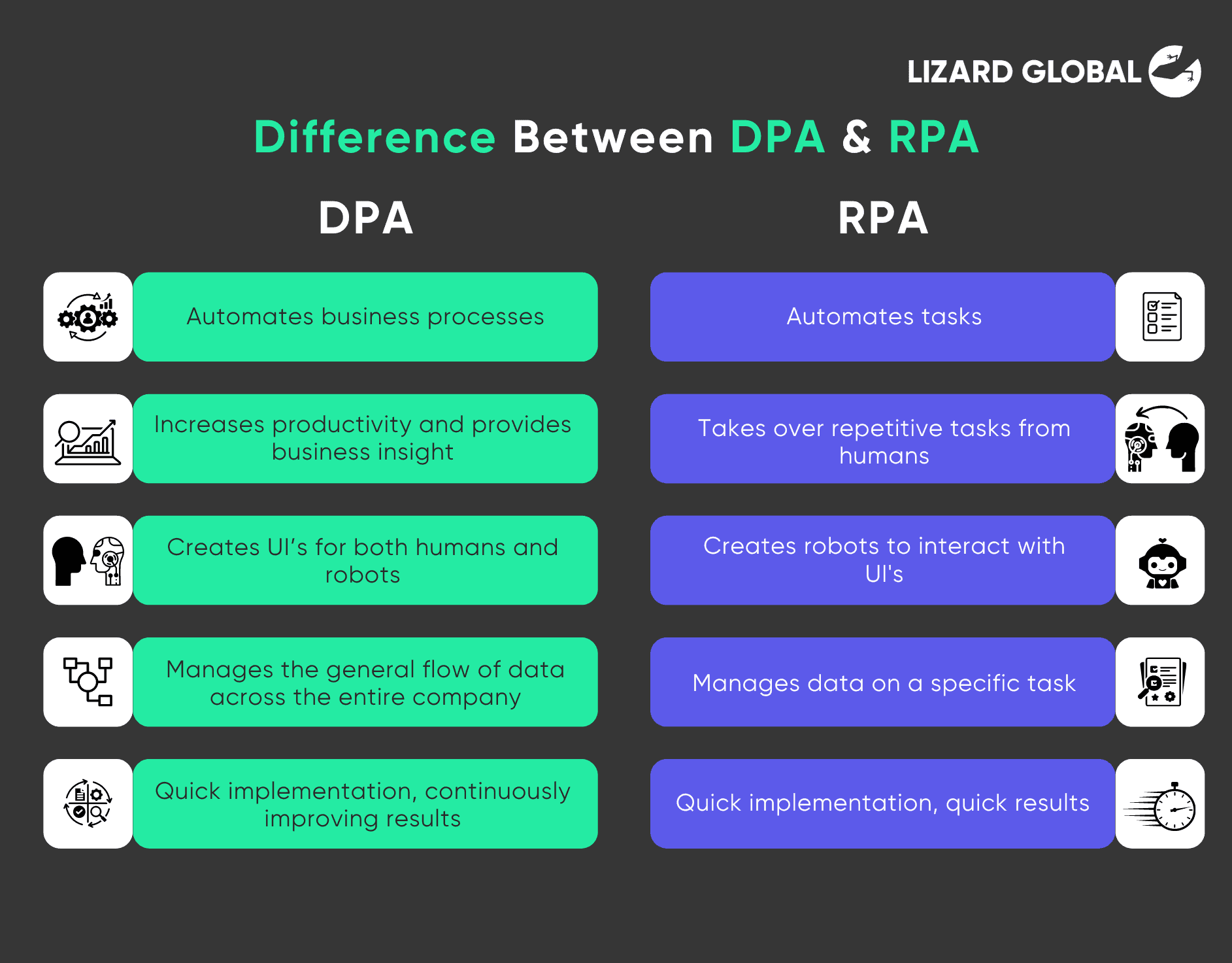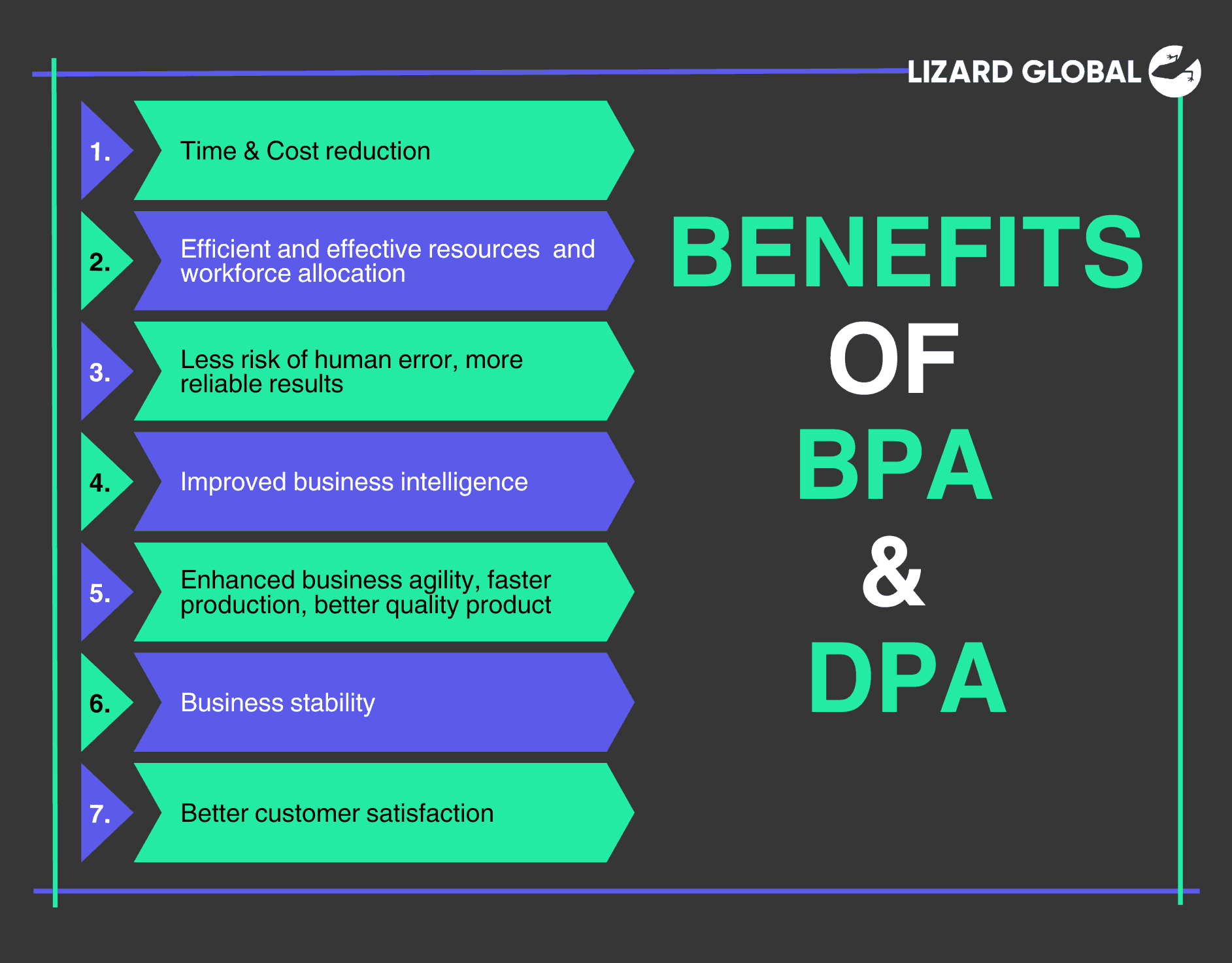Automation
Business Process Automation
+ 4 more ...
What Are Business Process Automation (BPA), Digital Process Automation (DPA), & Robotic Process Automation (RPA)?
25 Jun 2024
by Lotte, Digital Content Specialist & Nadiy, Content Writer
25 Jun 2024
by Lotte, Digital Content Specialist & Nadiy, Content Writer
Automation
Business Process Automation
Digital Transformation
Industry 4.0
Machine Learning
AI
What Are Business Process Automation (BPA), Digital Process Automation (DPA), & Robotic Process Automation (RPA)?
Table of contents
Contact us
We will get back to you in the next 48 hours.

What are Business Process Automation, Digital Process Automation, and Robotic Process Automation Lizard Global
The automation of business processes can bring your business to the next level of efficiency, resulting in a greater customer experience.
key takeaways
Your business might be up and running, but is it able to run on its own if necessary? Perhaps it’s a good idea to take a look at the processes within your organization that can benefit from the implementation of automation. With BPA, or Business Process Automation, you turn manual business processes into automated operations. Not only does this save you a lot of time and effort, it also prevents your business from collapsing in times of crisis. BPA can take your company to the next level of optimal performance by taking over tasks like transferring data and extracting information from databases. Automating processes like these, results in more time, money and space to focus on tasks that aren’t automated (yet).
What Is Business Process Automation (BPA) and Digital Process Automation (DPA)
BPA is generally used as an umbrella term and overarching concept for different kinds of process automation. One of the underlying kinds of process automation is DPA, or Digital Process Automation. DPA is focused on automating digital processes to improve the customer experience. The main difference is that DPA, as the name suggests, focuses on the digital aspect of process automation. DPA is, in that sense, a digital branch of BPA, as it goes along with the recent technological innovations implemented into businesses. DPA can be seen as a customer-centric approach to business management, as it eliminates all unnecessary manual procedures in order to put the main attention on the customer experience. In that sense, it relates closely to the idea of the human-centered approach of Design Thinking. Digital process automation also fits the mindset of Lean Startups and Agile methodologies. The automation of specific business processes lowers the risk of human error, and therefore facilitates a rapid and smooth flow of procedures, which results in a successful final product delivery and satisfied customer experience. DPA is a key pillar in an increasing number of industries, from logistics to maritime industries. It has become a core element of so-called Smart Manufacturing.
Implementing DPA
The ultimate goal of digital process automation is providing the customer with the best possible experience in the most efficient and effective way possible. This customer-centric approach revolves around the idea that every improvement you make has to bring value to your customers. If it doesn’t improve the customer experience, it shouldn’t be a part of your digital process automation. With that in mind, it is crucial to start the process of digital automation with a design thinking approach, in which empathy and understanding form the foundation of the digital transformation of your business.
Difference between DPA and RPA

RPA
RPA, or Robotic Process Automation, is another branch of BPA, and involves software robots (bots) that interact with business systems and processes, the same way humans would do it, but fully automated. RPA closely relates to the implementation of artificial intelligence and machine learning. The main difference is the fact that RPA still needs human supervision, while processes running on artificial intelligence are taught to think like a human, and therefore functions fully on its own. Whereas DPA is focused on automating business processes in order to improve a customer’s experience, RPA revolves around the automation of repetitive and rule-based tasks, formerly done by humans. By eliminating these tasks, employees have more time and space to focus on more value-adding tasks that need extra attention. In that sense, RPA greatly improves productivity, while DPA raises the quality of services. Together, they can streamline internal business processes in such a way it stimulates growth and stability in the long term.
RPA
- Automates tasks
- Takes over repetitive tasks from humans
- Creates robots to interact with UI's
- Manages data on a specific task
- Quick implementation, quick results
DPA
- Automates business processes
- Increases productivity and provides business insight
- Creates UI’s for both humans and robots
- Manages the general flow of data across the entire company
- Quick implementation, continuously improving results
Want to find out how much it costs to build your dream app or web app?
Customer Service Through DPA
Because DPA makes sure your business keeps running in times of crisis, automating your customer services helps to provide a more pleasant and streamlined customer experience. After all, keeping your customers satisfied by providing high-quality real-time service is probably the most important aspect of keeping your business on top of its game. In order to automate your customer service, you must be able to anticipate the questions your customers might have, and provide answers before they have to make the effort to ask them. This can be done by, for example, providing your customers with an extensive list of frequently asked questions (FAQs). Or even better: use the principles of design thinking in order to create a UI/UX of your website that is so intuitive that it doesn’t require information or raise questions amongst users. You can implement RPA into your customer service channels through the use of chatbots. Chatbots are automated digital helpdesks that answer customer questions based on previously and often ask questions. Artificial Intelligence (AI) and machine learning are often implemented for teaching chatbots information about customers and anticipating the questions they’re likely to ask. All information is then being processed and turned into a variety of fitting answers. Although chatbots are becoming increasingly advanced and intelligent, extensive and complex questions can still be challenging.
Benefits of BPA and DPA

More and more industries are transforming into digital businesses, and a large part of their internal processes can benefit greatly from automation. This means that you have to keep up with the general stream of worldwide digital transformation in order to stay relevant, no matter what industry you're in. And not only do the internal business processes need to be automated, the entire mindset of the company has to grow along. This involves the training of your employees, who need to understand exactly what automation is and how it impacts their current and future responsibilities. You may ask yourself, “why go through all this automation effort when everything seems to be doing okay already?” Here’s a list of all the benefits of automation to convince you to join a digital transformation:
- Time & cost reduction
- More efficient and effective allocation of resources and workforces
- Less risk of human error, and therefore more reliable results
- Improved business intelligence: a better insight into the business processes by data visualisation & dashboards
- Enhancement of internal business agility, resulting in fast production and consistent quality of products/services
- Automation creates stability which helps your business run smoothly in times of crisis
- And probably the most important benefit of all: greater customer satisfaction
We can help you automate your business
At Lizard Global, we are specialized in the automation of digital processes, and we gladly help and guide you with the digital transformation of your business. Lizard Global can help by consulting and helping to analyze your business problems and bottlenecks to come up with digital solutions that will make your business run more smoothly and efficiently. We already partnered up with a great range of businesses that asked for our support with their digital transformation. Check out our previous projects to see what we did. Want to know more about what we can do for your business and how we implement digital automation into your business to optimise its efficiency? Contact us by clicking the image below and get your FREE consultation today!

Join 2000+ subscribers
Stay in the loop with everything you need to know

What are Business Process Automation, Digital Process Automation, and Robotic Process Automation Lizard Global
The automation of business processes can bring your business to the next level of efficiency, resulting in a greater customer experience.
Your business might be up and running, but is it able to run on its own if necessary? Perhaps it’s a good idea to take a look at the processes within your organization that can benefit from the implementation of automation. With BPA, or Business Process Automation, you turn manual business processes into automated operations. Not only does this save you a lot of time and effort, it also prevents your business from collapsing in times of crisis. BPA can take your company to the next level of optimal performance by taking over tasks like transferring data and extracting information from databases. Automating processes like these, results in more time, money and space to focus on tasks that aren’t automated (yet).
What Is Business Process Automation (BPA) and Digital Process Automation (DPA)
BPA is generally used as an umbrella term and overarching concept for different kinds of process automation. One of the underlying kinds of process automation is DPA, or Digital Process Automation. DPA is focused on automating digital processes to improve the customer experience. The main difference is that DPA, as the name suggests, focuses on the digital aspect of process automation. DPA is, in that sense, a digital branch of BPA, as it goes along with the recent technological innovations implemented into businesses. DPA can be seen as a customer-centric approach to business management, as it eliminates all unnecessary manual procedures in order to put the main attention on the customer experience. In that sense, it relates closely to the idea of the human-centered approach of Design Thinking. Digital process automation also fits the mindset of Lean Startups and Agile methodologies. The automation of specific business processes lowers the risk of human error, and therefore facilitates a rapid and smooth flow of procedures, which results in a successful final product delivery and satisfied customer experience. DPA is a key pillar in an increasing number of industries, from logistics to maritime industries. It has become a core element of so-called Smart Manufacturing.
Implementing DPA
The ultimate goal of digital process automation is providing the customer with the best possible experience in the most efficient and effective way possible. This customer-centric approach revolves around the idea that every improvement you make has to bring value to your customers. If it doesn’t improve the customer experience, it shouldn’t be a part of your digital process automation. With that in mind, it is crucial to start the process of digital automation with a design thinking approach, in which empathy and understanding form the foundation of the digital transformation of your business.
Difference between DPA and RPA

RPA
RPA, or Robotic Process Automation, is another branch of BPA, and involves software robots (bots) that interact with business systems and processes, the same way humans would do it, but fully automated. RPA closely relates to the implementation of artificial intelligence and machine learning. The main difference is the fact that RPA still needs human supervision, while processes running on artificial intelligence are taught to think like a human, and therefore functions fully on its own. Whereas DPA is focused on automating business processes in order to improve a customer’s experience, RPA revolves around the automation of repetitive and rule-based tasks, formerly done by humans. By eliminating these tasks, employees have more time and space to focus on more value-adding tasks that need extra attention. In that sense, RPA greatly improves productivity, while DPA raises the quality of services. Together, they can streamline internal business processes in such a way it stimulates growth and stability in the long term.
RPA
- Automates tasks
- Takes over repetitive tasks from humans
- Creates robots to interact with UI's
- Manages data on a specific task
- Quick implementation, quick results
DPA
- Automates business processes
- Increases productivity and provides business insight
- Creates UI’s for both humans and robots
- Manages the general flow of data across the entire company
- Quick implementation, continuously improving results
Want to find out how much it costs to build your dream app or web app?
Customer Service Through DPA
Because DPA makes sure your business keeps running in times of crisis, automating your customer services helps to provide a more pleasant and streamlined customer experience. After all, keeping your customers satisfied by providing high-quality real-time service is probably the most important aspect of keeping your business on top of its game. In order to automate your customer service, you must be able to anticipate the questions your customers might have, and provide answers before they have to make the effort to ask them. This can be done by, for example, providing your customers with an extensive list of frequently asked questions (FAQs). Or even better: use the principles of design thinking in order to create a UI/UX of your website that is so intuitive that it doesn’t require information or raise questions amongst users. You can implement RPA into your customer service channels through the use of chatbots. Chatbots are automated digital helpdesks that answer customer questions based on previously and often ask questions. Artificial Intelligence (AI) and machine learning are often implemented for teaching chatbots information about customers and anticipating the questions they’re likely to ask. All information is then being processed and turned into a variety of fitting answers. Although chatbots are becoming increasingly advanced and intelligent, extensive and complex questions can still be challenging.
Benefits of BPA and DPA

More and more industries are transforming into digital businesses, and a large part of their internal processes can benefit greatly from automation. This means that you have to keep up with the general stream of worldwide digital transformation in order to stay relevant, no matter what industry you're in. And not only do the internal business processes need to be automated, the entire mindset of the company has to grow along. This involves the training of your employees, who need to understand exactly what automation is and how it impacts their current and future responsibilities. You may ask yourself, “why go through all this automation effort when everything seems to be doing okay already?” Here’s a list of all the benefits of automation to convince you to join a digital transformation:
- Time & cost reduction
- More efficient and effective allocation of resources and workforces
- Less risk of human error, and therefore more reliable results
- Improved business intelligence: a better insight into the business processes by data visualisation & dashboards
- Enhancement of internal business agility, resulting in fast production and consistent quality of products/services
- Automation creates stability which helps your business run smoothly in times of crisis
- And probably the most important benefit of all: greater customer satisfaction
We can help you automate your business
At Lizard Global, we are specialized in the automation of digital processes, and we gladly help and guide you with the digital transformation of your business. Lizard Global can help by consulting and helping to analyze your business problems and bottlenecks to come up with digital solutions that will make your business run more smoothly and efficiently. We already partnered up with a great range of businesses that asked for our support with their digital transformation. Check out our previous projects to see what we did. Want to know more about what we can do for your business and how we implement digital automation into your business to optimise its efficiency? Contact us by clicking the image below and get your FREE consultation today!

Join 2000+ subscribers
Stay in the loop with everything you need to know
FAQs

Can BPA and DPA be used together?
How do I start implementing BPA in my business?
What are the challenges of implementing BPA and DPA?
How does RPA differ from AI and machine learning?
What industries benefit the most from BPA and DPA?
How can I measure the success of BPA and DPA initiatives?
Why is digital transformation important for businesses?
What is the role of design thinking in DPA?







